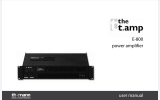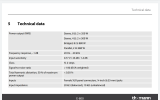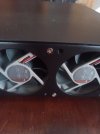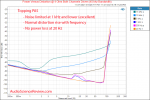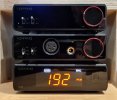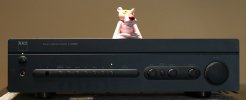It was only for a test, but yes, it was an active biamp. Don't recall the exact frequency I had it set to, but it was around 70-80Hz.Are you doing active biamp? What are the crossover freq?
-
WANTED: Happy members who like to discuss audio and other topics related to our interest. Desire to learn and share knowledge of science required. There are many reviews of audio hardware and expert members to help answer your questions. Click here to have your audio equipment measured for free!
- Forums
- Audio, Audio, Audio!
- Amplifiers, Phono preamp, and Analog Audio Review
- Stereo and Multichannel Amplifier Reviews
You are using an out of date browser. It may not display this or other websites correctly.
You should upgrade or use an alternative browser.
You should upgrade or use an alternative browser.
Topping PA5 Review (Amplifier)
- Thread starter amirm
- Start date
The spread (width of the main lobe) you see is mostly a function of the FFT window used. @pkane used the Dolph-Chebyshev 200 with an FFT length of 64k. The Dolph-Chebyshev window trades high side lobe attenuation at the expense of main lobe width.Regarding @pkane measurements, the 60hz and 7khz one is based on 5w? Also, may I know why the 60hz tone show such a wide range that cover 50hz to 70hz? Is it expected behavior for such measurement?
View attachment 183946
Here are comparisons of 5 different windows -- no window (= rectangular or boxcar window), Hann, Blackman, Blackman-Harris, and Dolph-Chebyshev. The FFT length of the first graph is 2^16 samples. In sample duration, the FFT length is an integer (14) multiple periods of ~20.5 Hz, and therefore we get a nice sharp peak with excellent side lobe attenuation when no window is used. The Dolph-Chebyshev window shows a side lobe width of about +/- 10 Hz (same width as in @pkane 's plot) and equivalent side lobe attenuation as no window.
In the second graph, the FFT length is increased by 64 samples and the sampling period is no longer an integer multiple of ~20.5 Hz. You can see the side lobe attenuations of all the curves except the Dolph-Chebyshev have become significantly worse. This shows that Dolph-Chebyshev is highly resistant to sampling length variations. You can also see the trade offs between main lobe width and side lobe attenuations for the various windows.
Pdxwayne
Major Contributor
- Joined
- Sep 15, 2020
- Messages
- 3,219
- Likes
- 1,172
Nice! Thanks!The spread (width of the main lobe) you see is mostly a function of the FFT window used. @pkane used the Dolph-Chebyshev 200 with an FFT length of 64k. The Dolph-Chebyshev window trades high side lobe attenuation at the expense of main lobe width.
Here are comparisons of 5 different windows -- no window (= rectangular or boxcar window), Hann, Blackman, Blackman-Harris, and Dolph-Chebyshev. The FFT length of the first graph is 2^16 samples. In sample duration, the FFT length is an integer (14) multiple periods of ~20.5 Hz, and therefore we get a nice sharp peak with excellent side lobe attenuation when no window is used. The Dolph-Chebyshev window shows a side lobe width of about +/- 10 Hz (same width as in @pkane 's plot) and equivalent side lobe attenuation as no window.
In the second graph, the FFT length is increased by 64 samples and the sampling period is no longer an integer multiple of ~20.5 Hz. You can see the side lobe attenuations of all the curves except the Dolph-Chebyshev have become significantly worse. This shows that Dolph-Chebyshev is highly resistant to sampling length variations. You can also see the trade offs between main lobe width and side lobe attenuations for the various windows.
View attachment 183985
View attachment 183986
Walter
Addicted to Fun and Learning
- Joined
- Aug 25, 2020
- Messages
- 856
- Likes
- 1,242
I am all for any new or existing tests that show differences between devices that are audible with music, even if by only 0.1% of listeners and only on one subgenre of music. The same holds if the test could show safety concerns, possible ability to damage other equipment in the chain, or an effect on reliability. However, I personally would prefer that Amir not spend time on any tests that are just for engineering bragging rights. I don't even consider such devices better engineered, but rather just another aspect of audiofoolery that simply goes after a different group than those that fall for snake oil. Amir could better spend this time testing other products or, shock, his personal life!
DanielT
Major Contributor
PA5 and state of the art desktop amp. Perfect for its purpose. Whether it works with the speakers in the living room, the listening room, in the main system, depends on the sensitivity of the speakers, listening distance, crest factor music. And it is always good with headroom power on amp so you do not risk it being driven into clipping.
Perfect for its purpose. Whether it works with the speakers in the living room, the listening room, in the main system, depends on the sensitivity of the speakers, listening distance, crest factor music. And it is always good with headroom power on amp so you do not risk it being driven into clipping.
Dividing the signal and letting another amp take care of the bass frequency, which several have mentioned, is smart. Relieve PA5. It is in the bass frequencies a lot of power is needed. For bass there I would take for example:
Conclusions
The Behringer A800 does what pro amps try to do: provide solid, middle-of-the-road distortion and noise with tons of power in quiet and light package for little money. The design is stable and better than the A500. As such, I can recommend the A800 as an everyday amplifier.

 audiosciencereview.com
audiosciencereview.com
When I think about it, I would probably have an open mind and think about IF a800 would work as a full register amp. That is, what would a PA5 add if you have an a800? Of course an a800 is not as small as a PA5 so go back to square one again:
PA5 and state of the art desktop amp
Distortion levels 19-20 kHz I saw discussed. Ignore that. It is extremely difficult to believe that someone who writes in this thread hears such high frequencies. If you are under 20 years, maybe.
Edit:
I have the brother, e800 as sub amp. Now with silent Noctua fans. Works fine.
Dividing the signal and letting another amp take care of the bass frequency, which several have mentioned, is smart. Relieve PA5. It is in the bass frequencies a lot of power is needed. For bass there I would take for example:
Conclusions
The Behringer A800 does what pro amps try to do: provide solid, middle-of-the-road distortion and noise with tons of power in quiet and light package for little money. The design is stable and better than the A500. As such, I can recommend the A800 as an everyday amplifier.

Behringer A800 Stereo Amplifier Review
This is a review and detailed measurements of the Behringer A800 Class D Stereo Amplifier. It is on kind loan from a member. The A800 costs US $299 including free shipping from multiple sites. The member who loaned it me has done a youtube video of it which you can see by clicking on this...
 audiosciencereview.com
audiosciencereview.com
When I think about it, I would probably have an open mind and think about IF a800 would work as a full register amp. That is, what would a PA5 add if you have an a800? Of course an a800 is not as small as a PA5 so go back to square one again:
PA5 and state of the art desktop amp
Distortion levels 19-20 kHz I saw discussed. Ignore that. It is extremely difficult to believe that someone who writes in this thread hears such high frequencies. If you are under 20 years, maybe.
Edit:
I have the brother, e800 as sub amp. Now with silent Noctua fans. Works fine.
Attachments
Last edited:
My wife does. Usually from another room.Distortion levels 19-20 kHz I saw discussed. Ignore that. It is extremely difficult to believe that someone who writes in this thread hears such high frequencies.
DanielT
Major Contributor
Not everyone has such a young wife.My wife does. Usually from another room.
gfinlays
Active Member
- Joined
- May 30, 2020
- Messages
- 179
- Likes
- 333
The 19 & 20 kHz IMD test is an important test as the 1 kHz difference tone can pop up in the audio band. However, in the case of the PA5, even at 5 W power output, the 1 kHz difference tone was >119 dB down on the fundamental tones..PA5 and state of the art desktop amp.Perfect for its purpose. Whether it works with the speakers in the living room, the listening room, in the main system, depends on the sensitivity of the speakers, listening distance, crest factor music. And it is always good with headroom power on amp so you do not risk it being driven into clipping.
Dividing the signal and letting another amp take care of the bass frequency, which several have mentioned, is smart. Relieve PA5. It is in the bass frequencies a lot of power is needed. For bass there I would take for example:
Conclusions
The Behringer A800 does what pro amps try to do: provide solid, middle-of-the-road distortion and noise with tons of power in quiet and light package for little money. The design is stable and better than the A500. As such, I can recommend the A800 as an everyday amplifier.

Behringer A800 Stereo Amplifier Review
This is a review and detailed measurements of the Behringer A800 Class D Stereo Amplifier. It is on kind loan from a member. The A800 costs US $299 including free shipping from multiple sites. The member who loaned it me has done a youtube video of it which you can see by clicking on this...audiosciencereview.com
When I think about it, I would probably have an open mind and think about IF a800 would work as a full register amp. That is, what would a PA5 add if you have an a800? Of course an a800 is not as small as a PA5 so go back to square one again:
PA5 and state of the art desktop amp
Distortion levels 19-20 kHz I saw discussed. Ignore that. It is extremely difficult to believe that someone who writes in this thread hears such high frequencies. If you are under 20 years, maybe.
Last edited:
SINAD at 1Khz. Ignore that your not gonna listen to 1khz sine wave.Distortion levels 19-20 kHz I saw discussed. Ignore that.
If you know how to interpret them tests can tell you more then the spec are testing
An inter modulation test is reviling non linearity not only over 19Khz this is just an industry standard test.
But There is nothing magical about 19/20k. lots of other standards exist for IMD tests.
Thing about "science" you don't need "realsitik" tests. you need reveling tests and he knowledge to interpret them.
Why not put an speaker an DAC on the Amps and listen to some Toto and ask the wive how it sounds from the kitchen.
Way more Realistic.... no one is gonna uses this amp to power a dummy Load with 1khz sine waves.
DanielT
Major Contributor
You then have to decide for yourself. I think it looks good, see attached picture. Note the price of PA5 in addition!The 19 & 20 kHz IMD test is an important test as the 1 kHz difference tone can pop up in the audio band. However, in the case of the PA5, even at 5 W power output, the 1 kHz difference tone was >119 dB down on the tundamental tones..
It's the old usual regarding class D that sneaks on, you know class D is only suitable for sub amp, no hifi quality on the sound in the higher frequencies. That is now overplayed. Check, for example, good constructions of:
Bruno Putzeys, Co-Founder
Inventor of UcD (Philips), probably still the most widely used class-D amplifier for upmarket audio products. Inventor of Ncore (Hypex), which is generally considered the first class-D amplifier to successfully compete with class-A on audio performance. Developed high performance A / D and D / A converter designs for Grimm and Mola-Mola. Co-founder of Kii Audio. Holds 9 patents and multiple patent disclosures.

about | PURIFI
Class D here and now and my guess in the future the only amplifier class on the market. Who knows class AB for enthusiasts in the future similar to those who are currently doing tube amps? For nostalgia's sake.
Attachments
DanielT
Major Contributor
See my post above.SINAD at 1Khz. Ignore that your not gonna listen to 1khz sine wave.
If you know how to interpret them tests can tell you more then the spec are testing
An inter modulation test is reviling non linearity not only over 19Khz this is just an industry standard test.
But There is nothing magical about 19/20k. lots of other standards exist for IMD tests.
Thing about "science" you don't need "realsitik" tests. you need reveling tests and he knowledge to interpret them.
Why not put an speaker an DAC on the Amps and listen to some Toto and ask the wive how it sounds from the kitchen.
Way more Realistic.... no one is gonna uses this amp to power a dummy Load with 1khz sine waves.
gfinlays
Active Member
- Joined
- May 30, 2020
- Messages
- 179
- Likes
- 333
I already haveYou then have to decide for yourself. I think it looks good, see attached picture. Note the price of PA5 in addition!
It's the old usual regarding class D that sneaks on, you know class D is only suitable for sub amp, no hifi quality on the sound in the higher frequencies. That is now overplayed. Check, for example, good constructions of:
Bruno Putzeys, Co-Founder
Inventor of UcD (Philips), probably still the most widely used class-D amplifier for upmarket audio products. Inventor of Ncore (Hypex), which is generally considered the first class-D amplifier to successfully compete with class-A on audio performance. Developed high performance A / D and D / A converter designs for Grimm and Mola-Mola. Co-founder of Kii Audio. Holds 9 patents and multiple patent disclosures.

about | PURIFI
purifi-audio.com
Class D here and now and my guess in the future the only amplifier class on the market. Who knows class AB for enthusiasts in the future similar to those who are currently doing tube amps? For nostalgia's sake.
Attachments
DanielT
Major Contributor
You then have to decide for yourself. I think it looks good, see attached picture. Note the price of PA5 in addition!

about | PURIFI
purifi-audio.com
Class D here and now and my guess in the future the only amplifier class on the market. Who knows class AB for enthusiasts in the future similar to those who are currently doing tube amps? For nostalgia's sake.
Except that many amplifiers won't have that blue line, or that green line on your attached picture. I'll even go one further and say most well designed amplifiers won't show that since most well designed amplifiers can meet a .02% or less 20Hz to 20kHz specification. They don't produce nearly .1%THD+N at 20kHz, and haven't done that for decades unless they're really, really cheap, badly designed, or some sort of tube amp. So, no, it does not "look good". Now ask yourself ... if the amplifier appears to be losing linearity at high frequencies, what else might that cause? To say it does not matter is a pretty big leap of faith.
Last edited:
BoredErica
Addicted to Fun and Learning
Ok so at this point despite pma or restorer john or ryanmh1 bringing the same point up, we don't need 5w+ testing at 19+20khz for pa5. This is settled? Can we agree and move on and not randomly bring it up a week later?
Last edited:
DanielT
Major Contributor
You have to decide for yourself if it's ok. Or buy a class AB based used amp for less money, about the same amount of power:Except that many amplifiers won't have that blue line, or that green line on your attached picture. I'll even go one further and say most well designed amplifiers won't show that since most well designed amplifiers can meet a .02% or less 20Hz to 20kHz specification. They don't produce nearly .1%THD+N at 20kHz, and haven't done that for decades unless they're really, really cheap, badly designed, or some sort of tube amp. So, no, it does not "look good". Now ask yourself ... if the amplifier appears to be losing linearity at high frequencies, what else might that cause? To say it does not matter is a pretty big leap of faith.
To be clear, I did almost buy one of these. Couldn't get over the issues for the price. Instead I bought something with a lot more features and what-not for about the price. Guaranty you I could probably never hear a difference anyway.
Those of you who hate class-D spectra in ultrasonics, can rejoice now

Review and Measurements of NAD C 320BEE PWR Amplifier
This is a review and detailed measurements of the NAD C 320BEE power (speaker) amplifier. It is on kind loan. The C 320BEE is a vintage product, dating back to 2003 I think. The BEE designation is apparently a reference to Bjorn Erik Edvardsen who was one of their designers. Can't tell if he...
 audiosciencereview.com
audiosciencereview.com
... old amplifiers may need to be serviced and a recap . The usual, pros and cons of buying old amplifiers.
Edit:
That NAD example, check inputs, outputs (attached pictures). Maybe there is one with remote control? Had I chosen, well it would not have been a difficult choice. But with that said, as I said earlier. PA5 is small and handy. New in addition, guarantees at purchase new.
Note I do not diss PA5, I think it seems to be a good amp. Everyone can make their choices based on their needs.
Or wait now. This one I was about to forget. Guaranteed cheaper than PA5.

Receiver NAD C 720BEE
I took some pictures of a NAD C 720BEE I bought yesterday. It lacks a remote control, but I will get one, a remote control that is.The model of remote control is NAD SR5. It says Zone 2 on my NAD. I suspect that there are different types of NAD SR5. Am I right about that? Anyone who knows...
 audiosciencereview.com
audiosciencereview.com
Attachments
Last edited:
Walter
Addicted to Fun and Learning
- Joined
- Aug 25, 2020
- Messages
- 856
- Likes
- 1,242
To clarify, I am not talking specifically about the two tone IMD test (unless done at ridiculously high power level). I am just making a general statement, and I'm also just stating my personal opinion.I am all for any new or existing tests that show differences between devices that are audible with music, even if by only 0.1% of listeners and only on one subgenre of music. The same holds if the test could show safety concerns, possible ability to damage other equipment in the chain, or an effect on reliability. However, I personally would prefer that Amir not spend time on any tests that are just for engineering bragging rights. I don't even consider such devices better engineered, but rather just another aspect of audiofoolery that simply goes after a different group than those that fall for snake oil. Amir could better spend this time testing other products or, shock, his personal life!
After 1 week of listening I'm so glad to bought this PA5. I sold a Nad 302 ad another vintage gear which was in my basement and with the money earned I got this small gem. I play in another league now. No noise comes from the speakers and the sound is crystal clear and well detailed.
DanielT
Major Contributor
Congratulations. It seems good what you say.After 1 week of listening I'm so glad to bought this PA5. I sold a Nad 302 ad another vintage gear which was in my basement and with the money earned I got this small gem. I play in another league now. No noise comes from the speakers and the sound is crystal clear and well detailed.
I just wish I had brought to the protocols,because I mentioned used earlier in the thread.Old amp may need to be serviced and need to be recap. Can you not do it yourself but submit to a professional repairer, who charges per hour, then it will be expensive ... it WILL then be ... EXPENSIVE. There is nothing to fuss about. Is it worth it? Who knows , maybe. Just so you do not imagine that the wallet will not be an essential part of the solution.
Old amp with humming transformers (mechanical hum, from it itself, not out into the speakers). Well, it's a matter of taste whether you accept it or not.
Edit:
Old amp you can fiddle with if you have the knowledge to fiddle with old amp.
(or in some other way help your friend who does it, various services, exchange electronics)
Last edited:
Similar threads
- Replies
- 59
- Views
- 8K
- Poll
- Replies
- 891
- Views
- 181K
- Replies
- 15
- Views
- 965
- Replies
- 25
- Views
- 5K
- Replies
- 1K
- Views
- 173K

